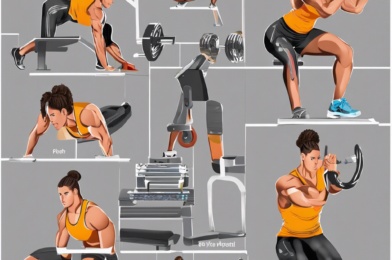Meal prep can be a game-changer for busy individuals who strive to maintain a healthy lifestyle and fitness routine. With the right strategies and recipes, you can fuel your body with nutritious meals while saving time and effort during the week. Let’s explore some meal prep ideas and recipes that will revolutionize the way you approach healthy eating.
**Batch Cooking Basics**
Meal prep begins with batch cooking, where you prepare larger portions of base ingredients that can be used in multiple meals. Dedicate a specific time during the week, perhaps Sunday afternoon, to batch cook ingredients like grains (quinoa, brown rice), proteins (chicken, tofu, lentils), and roasted vegetables. By having these basics ready, assembling meals throughout the week becomes a breeze. Store your batch-cooked items in separate containers to easily mix and match during meal prep.
**Meal Prep Strategies**
1. **Plan Your Meals:** Take time to plan a week’s worth of meals. Consider your nutritional needs, preferences, and any specific fitness goals. Balance your meals with adequate protein, complex carbohydrates, and healthy fats to fuel your workouts and support recovery.
2. **Use Standard Containers:** Invest in a set of quality meal prep containers. Look for ones that are airtight, leak-proof, and microwave/dishwasher safe. Standardizing container sizes ensures that you portion meals evenly and maximizes space in your refrigerator or freezer.
3. **Assembling Meals:** Once you’ve batch-cooked your base ingredients, it’s time to assemble! Portion out your proteins, carbohydrates, and vegetables into separate containers, creating well-balanced meals. Aim for variety in flavors and colors to make your meals exciting and appetizing.
4. **Seasoning and Spices:** Don’t underestimate the power of herbs and spices! They add immense flavor to your meals without the need for excessive salt or unhealthy additives. Experiment with different spice blends to create tasty themes for your prepped meals, like a taco seasoning for Mexican bowls or an Italian herb mix for pasta dishes.
5. **Keep it Fresh:** Incorporate fresh produce into your meals to boost flavor and nutrition. Leafy greens, tomatoes, avocados, and citrus fruits can be added right before serving to maintain their freshness and texture.
**Meal Prep Recipe Ideas**
1. **Chicken Quinoa Burrito Bowls:** Batch cook quinoa and shredded chicken, then assemble bowls with black beans, corn, diced tomatoes, avocado, and shredded cheese. Top with a squeeze of lime and cilantro for a tasty, well-rounded meal.
2. **Chickpea Curry with Rice:** Prepare a large batch of chickpea curry, packed with spices and vegetables. Serve alongside batch-cooked rice for a filling and flavorful meal.
3. **Veggie Pasta Salad:** Toss cooked pasta with roasted vegetables, cherry tomatoes, spinach, and a tangy vinaigrette. Top with grilled chicken or shrimp for added protein.
4. **Breakfast Muffin Cups:** Whip up a batch of egg muffin cups packed with vegetables and cheese. These portable breakfast bites are perfect for busy mornings and can be customized with various fillings.
5. **Overnight Oats:** Prepare overnight oats in individual jars, layering oats with your choice of milk, yogurt, chia seeds, and toppings like berries, nuts, or nut butter. This no-cook option is a time-saver and a nutritious breakfast option.
Meal prep is a journey, and with each attempt, you’ll refine your processes and discover new flavors and combinations that work for your tastes and fitness goals.
Happy prepping and enjoy the delicious, healthy results!






